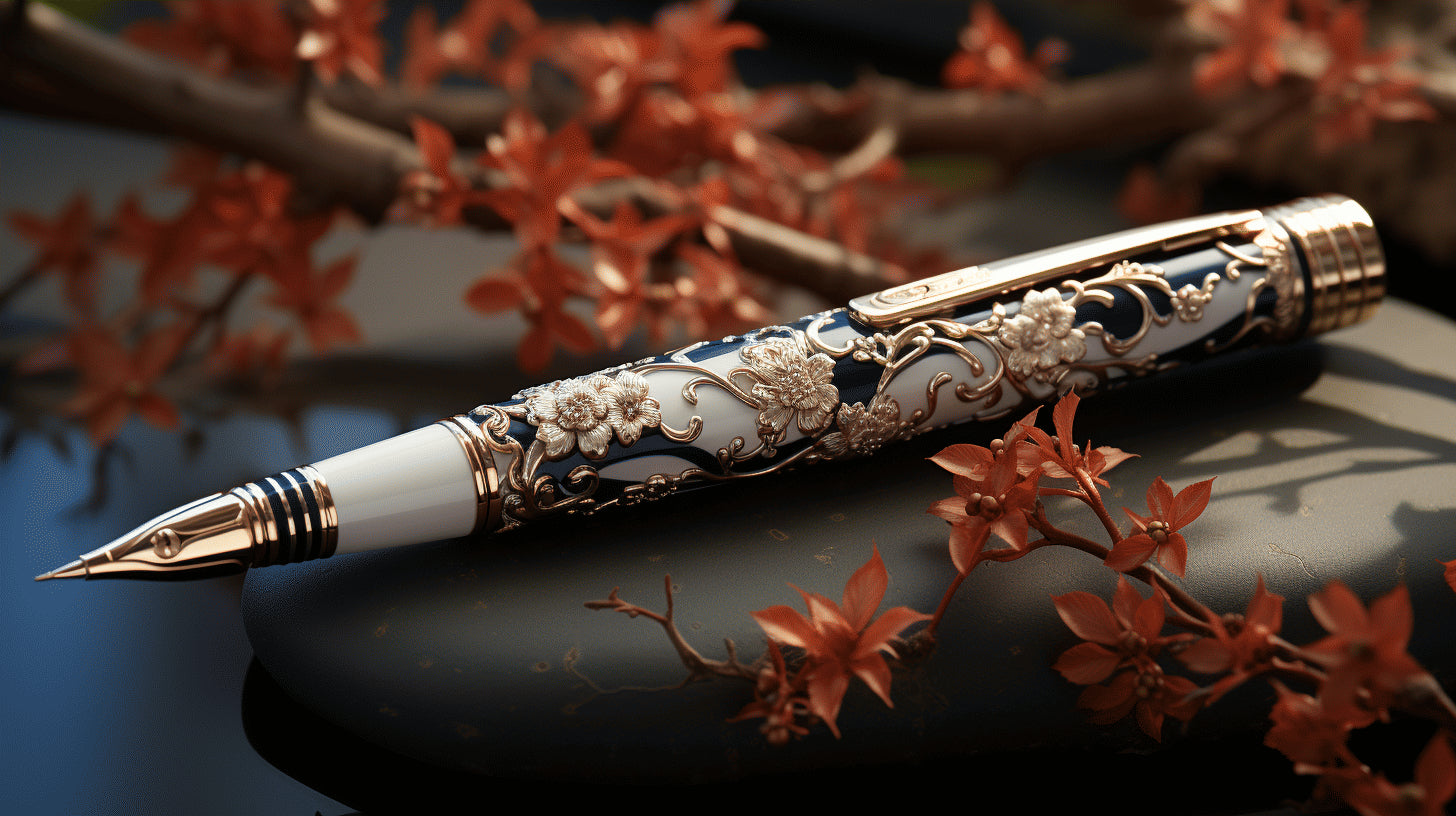
Embrace the Joy of Writing: Rediscover the Pleasure of Fountain Pens
In a world dominated by digital technology, the act of writing by hand has become increasingly rare. However, there is one writing tool that has stood the test of time and continues to captivate the hearts of writers and enthusiasts alike - the fountain pen. With its elegant design, smooth ink flow, and unparalleled writing experience, the fountain pen brings a touch of nostalgia and sophistication to the act of putting pen to paper.
While the convenience of digital writing cannot be denied, there is something truly magical about the tactile nature of using a fountain pen. The way the pen glides effortlessly across the page, leaving behind a trail of ink, is a blissful experience that simply can't be replicated by a keyboard or touchscreen.
But why should you consider embracing the joy of writing with a fountain pen? What benefits does it offer over its digital counterparts? In this article, we will explore the various advantages of using a fountain pen and why it may be worth rediscovering the pleasure of this classic writing instrument.
So, if you're ready to embark on a journey that combines the artistry of writing with the practicality of everyday use, join us as we delve into the world of fountain pens and all they have to offer. It's time to put pen to paper and experience the joy of writing in its purest form.
Benefits of Fountain Pens
Fountain pens have been a beloved writing instrument for centuries, and it's no wonder why. They offer a host of benefits that can greatly enhance your writing experience. Whether you're a student, professional, or simply enjoy putting pen to paper, fountain pens have something to offer for everyone. Let's explore some of the top advantages of using a fountain pen:
1. Smooth Writing Experience
One of the most notable benefits of using a fountain pen is the remarkable smoothness it provides. Unlike ballpoint or gel pens, which require pressure to transfer ink onto the page, fountain pens utilize a liquid ink system. This allows the pen to glide effortlessly across the paper, resulting in a more enjoyable and comfortable writing experience. The smooth flow of ink makes writing with a fountain pen a true pleasure.
2. Improved Handwriting
Want to improve your handwriting? Look no further than a fountain pen. Due to their smooth ink flow, fountain pens naturally encourage a slower writing pace. This enables you to focus on each stroke and letter, resulting in improved penmanship and neater handwriting. As the saying goes, "practice makes perfect," and writing with a fountain pen can be a great way to practice and refine your handwriting skills.
3. Reduced Hand Fatigue
Long writing sessions can often lead to hand fatigue and discomfort. However, fountain pens offer a solution to this problem. With their ergonomic design and balanced weight, fountain pens allow for extended writing without causing strain on your hand muscles. The light touch required to write with a fountain pen reduces the pressure exerted on your fingers, resulting in less fatigue and more comfortable writing sessions.
4. Enhanced Individual Writing Styles
Every writer has their own unique writing style, and fountain pens allow you to truly express and showcase your individuality. The flexibility of fountain pen nibs allows for variations in line thickness, giving your writing a distinctive flair. Whether you prefer a fine, medium, or broad nib, there is a fountain pen out there that will cater to your personal writing style. Embrace your creativity and make your mark with a fountain pen.
5. Personalization
In addition to their functional benefits, fountain pens also offer a wide range of personalization options. You can choose from different nib sizes, allowing you to have the perfect thickness for your writing style. Additionally, fountain pens come in a variety of stylish designs, materials, and colors to suit your taste and preference. From sleek and minimalist designs to ornate and eye-catching patterns, fountain pens can be a reflection of your personal style and individuality.
In conclusion, the benefits of using a fountain pen extend far beyond their functional uses. Fountain pens offer a smooth writing experience, improved handwriting, reduced hand fatigue, enhanced individual writing styles, and personalization options. So, why not treat yourself to a fountain pen and discover the joy of writing with this classic and elegant instrument? Fountain pens are worth it for anyone who values the art of writing and wants to elevate their writing experience. Find out more about fountain pens here.
Creativity and Expression in Writing
Writing is not just about conveying information; it is also an art form that allows individuals to express their unique thoughts, emotions, and perspectives. One tool that can elevate the writing experience and enhance creativity and expression is the fountain pen.
A fountain pen offers a smooth and fluid writing motion that encourages the flow of ideas and emotions onto paper. The effortless glide of the nib creates a connection between the writer and the words, allowing for a more intimate and personal writing experience.
When writing with a fountain pen, the act of putting ink to paper becomes more than just a mechanical action; it becomes an expressive act. The tactile sensation of holding a fountain pen and the deliberate strokes required for writing can ignite a sense of mindfulness and presence in the writing process.
Using a fountain pen can also be a form of self-expression. With a wide variety of ink colors and pen designs available, writers can choose a pen that reflects their personality or mood. Whether it's a bold and vibrant ink or a classic and elegant design, the fountain pen becomes an extension of the writer's identity, allowing them to make a statement with their writing.
Furthermore, writing with a fountain pen can make the act of writing more enjoyable and meaningful. The ritual of filling the pen with ink, the gentle pressure required for writing, and the satisfaction of seeing ink flow onto the page can turn a mundane task into a pleasurable experience. This enjoyment and connection to the writing process can inspire writers to explore their creativity and delve deeper into their thoughts and ideas.
By using a fountain pen, writers can enrich their writing experience, allowing their creativity and expression to flourish. So why not pick up a fountain pen and see how it can transform your writing journey?
To learn more about elevating your writing experience with handcrafted fountain pens, check out this article on our website, The Fountain Pen Journal.
Improved Penmanship and Coordination
Fountain pens are not just elegant writing instruments; they can also have a positive impact on your penmanship and coordination. The unique design and writing experience of a fountain pen can help you develop better control and precision in your writing. Here's how regular use of a fountain pen can lead to improved penmanship and coordination:
- Control and Precision: Unlike ballpoint or gel pens, fountain pens require a lighter touch and a more controlled grip. Writing with a fountain pen forces you to slow down and pay attention to your writing, resulting in more deliberate and precise letterforms. This focus on control can help you refine your penmanship over time.
- Flow and Consistency: Fountain pens use liquid ink that flows smoothly onto the paper. This consistent ink flow allows for a more even and uniform stroke, resulting in cleaner and more legible writing. The smooth writing experience provided by a fountain pen encourages you to write with a steady hand, promoting a smooth and consistent writing style.
- Hand-Eye Coordination: Using a fountain pen requires a higher level of hand-eye coordination compared to other types of pens. The design of a fountain pen, with its fine nib and the need to maintain a consistent angle, helps develop and refine your hand-eye coordination. As you write with a fountain pen, you learn to control the pressure, angle, and movement of the pen, which can have a positive impact on your overall coordination skills.
Incorporating a fountain pen into your writing routine can lead to improved penmanship and coordination. If you're new to using a fountain pen or want to learn more about the art of writing with one, check out this Beginner's Guide to Writing. It's a comprehensive resource that will help you get started on your fountain pen journey and discover the joys of elegant, precise writing. So why not give it a try and experience the benefits for yourself?
Technical Aspects of Fountain Pens
Fountain pens, with their elegant and timeless designs, offer a unique and luxurious writing experience. But what sets them apart from other writing instruments? Let's dive into the technical aspects of fountain pens and explore the fascinating mechanisms behind them.
Liquid Ink Flow
One of the key features of a fountain pen is its ability to deliver a smooth and consistent flow of liquid ink onto paper. Unlike ballpoint or rollerball pens, which rely on viscous ink paste or gel, fountain pens use liquid ink that flows effortlessly onto the page. This liquid ink is stored in a reservoir or ink cartridge within the pen.
The ink flows from the reservoir to the nib, which is the metal tip that comes into contact with the paper. The nib consists of a slit that runs lengthwise along its surface, allowing the ink to reach the tip. At the end of the nib, there is a small metal ball called the feed, which regulates the ink flow. As you write, the ink is drawn from the reservoir onto the feed and then onto the paper through capillary action, creating a beautiful, uninterrupted line.
This unique mechanism not only provides a visually appealing writing experience but also gives you the ability to create variations in your writing style. By adjusting the angle and pressure of the nib against the paper, you can achieve different line widths and shading effects.
Smooth Writing Experience
Another significant advantage of using a fountain pen is the effortless and comfortable writing experience it offers. Unlike ballpoint pens that require pressure to create contact between the ball and the paper, fountain pens glide smoothly over the surface with minimal effort.
The design of the nib plays a crucial role in the smoothness of the writing experience. Fountain pen nibs are typically made of alloys such as stainless steel or gold. These materials provide the necessary flexibility to adapt to the varying pressure exerted while writing. The nib's tines (the two prongs that form the tip of the nib) spread apart slightly, allowing the ink to flow more smoothly.
Using a fountain pen requires less pressure and grip compared to other pens, making it an excellent option for individuals with hand or wrist pain. The effortless movement across the paper reduces strain and fatigue, allowing for longer writing sessions without discomfort.
To further enhance the smoothness of the writing experience, fountain pens are often paired with high-quality, lubricated inks. These inks have additives that reduce friction between the nib and the paper, resulting in an even more enjoyable writing experience.
Understanding the technical aspects of fountain pens reveals the thought and craftsmanship behind these exquisite writing instruments. Whether you're a seasoned fountain pen enthusiast or new to the world of fine writing, exploring the intricate workings of fountain pens adds an extra layer of appreciation for these timeless classics.
To learn more about how a fountain pen works and gain deeper insights into this captivating mechanism, check out How A Fountain Pen Works.
Market Outlook for Fountain Pens
The market for fountain pens has seen a steady growth in recent years, with enthusiasts and pen aficionados rediscovering the joy and pleasure of writing with these timeless instruments. There are several factors contributing to this growth, ranging from the revival of nostalgia to the rising demand for personalized and unique writing experiences. Let's take a closer look at the market outlook for fountain pens.
Expected Market Growth
Industry experts predict a positive trajectory for the fountain pen market in the coming years. As more people embrace the art of writing and seek out elevated writing experiences, the demand for fountain pens is expected to increase. This growth can be attributed to several key factors:
- Rising interest in calligraphy and hand-lettering: Fountain pens offer a smooth and controlled writing experience, making them the preferred choice for calligraphers and hand-lettering artists. As these hobbies gain popularity, the demand for fountain pens is also on the rise.
- Shift towards personalization: In a world dominated by digital communication, there is a growing desire for more personalized and unique experiences. Fountain pens offer the opportunity to express one's individuality through the choice of pen materials, nib sizes, and ink colors, allowing writers to create their own signature style.
- Aesthetic appeal and craftsmanship: Fountain pens are often considered works of art. From their elegant designs to the precision craftsmanship required to create them, fountain pens embody a timeless charm that appeals to collectors and connoisseurs.
Current Market Size
The current market for fountain pens reflects the growing interest in these writing instruments. While the market is not as large as the mainstream ballpoint pen market, it holds a dedicated and passionate customer base. Key players in the fountain pen industry continue to innovate and introduce new designs and features to cater to the demands of discerning writers.
As the market for fountain pens continues to expand, manufacturers are finding new ways to cater to a diverse customer base, offering a range of options in terms of price, materials, and design. From entry-level fountain pens that provide an affordable introduction to the world of fountain pens to high-end luxury models crafted with precious materials, there is a fountain pen for every taste and budget.
In conclusion, the market outlook for fountain pens is promising. With a strong focus on personalization, craftsmanship, and the unique writing experience they offer, fountain pens are poised to continue their resurgence in popularity. As more individuals rediscover the joy of writing with a fountain pen in hand, the market is set to thrive, catering to a growing community of writing enthusiasts.
Frequently Asked Questions
-
What are fountain pens?
Fountain pens are writing instruments that use liquid ink. Unlike ballpoint pens, fountain pens have a nib that draws ink from a reservoir and allows for a smoother and more controlled writing experience.
-
Why should I use a fountain pen?
Using a fountain pen can enhance your writing experience and bring back the joy of writing. The smooth flow of ink, the comfort in hand, and the precise control over the thickness of lines can make writing more pleasurable and enjoyable.
-
Are fountain pens difficult to use?
Fountain pens may require a bit of initial practice, but they are not difficult to use. With a little patience and proper technique, you can quickly get accustomed to the unique writing style of fountain pens.
-
Do fountain pens require special ink?
Fountain pens require fountain pen ink, which is specifically formulated to work well with the pen's mechanism. You can find a wide variety of high-quality fountain pen inks in various colors and shades.
-
Can I use a fountain pen for everyday writing?
Absolutely! Fountain pens can be used for everyday writing tasks. They are not only great for personal journaling and letter writing but also for professional use, such as taking notes, signing documents, or creating artistic pieces.







Leave a comment
This site is protected by hCaptcha and the hCaptcha Privacy Policy and Terms of Service apply.